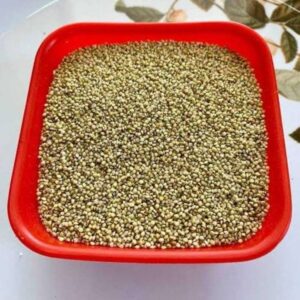
Millet
United States Department of Agriculture states that millet is a cereal grain that belongs to the Poaceae family, commonly known as the grass family. In its origin, Nithiyanantham et al. (2019) found that millet is highly eaten in developing countries throughout Africa and Asia. Though it resembles a seed, millet’s nutritional content is akin to that of sorghum and other cereals. Another study by Muthamilarasan et al. (2015) also reports that the popularity of millet has advanced in the West because it contains high protein, fibre and antioxidants.
Ugare et al. (2015) also found that millet is a low glycemic index diet. Their study found dehulled (50.0) and heat treated (41.7) barnyard millet beneficial for type-II diabetics. It’s also an alkaline food, which means that it can digest easily, a good option for those with sensitive stomachs.
Nutritional composition
Sarita, E (2016) study found that as pertains to most cereals, millet is a starchy grain — meaning that it’s rich in carbs. Additionally, millet is loaded with several vitamins and minerals.
According to the US Department of Agriculture, one cup (174 grams) of cooked millet packs has the following:
- Calories: 207
- Carbs: 41 grams
- Fiber: 2.2 grams
- Protein: 6 grams
- Fat: 1.7 grams
- Phosphorus: 25 percent of the Daily Value (DV)
- Magnesium: 19 percent of the DV
- Folate: 8 percent of the DV
- Iron: 6 percent of the DV
Also, three studies (Singh, 2,016; Dias-Martins et al. 2018; Wu, 2009) found that millet gives more essential amino acids as compared to other cereals, and they are the building blocks of protein.
Another interesting thing is that finger millet can take the bragging right as cereal with the abundant calcium content, giving the body 13 percent of the daily value per 1 cooked cup (100 grams) (Singh, 2016; Devi et al. 2014; Shobana et al. 2013). As you are aware, the human body needs calcium for good bone health, blood vessel and muscular contractions, and proper nerve function.
Millet – the science
Antioxidants Loaded
Six studies (Devi et al. 2016; Kumari et al. 2017; Pizino et al. 2017; Xiang et al. 2019; Chandrasekara and Shahidi, 2010) confirmed that millet is loaded with phenolic compounds, specifically ferulic acid and catechins. They work as antioxidants to guard the body against harmful oxidative stress.
Other studies in mice( Zduńska et al. 2017 Liu et al. 2017) correlate ferulic acid to fast wound healing, skin protection, and anti-inflammatory properties. It has been established that these catechins bind to heavy metals and avert poisoning our bloodstream (Chandrasekara and Shahidi, 2010; Bernatoniene and Kopustinskiene, 2018).
Kumari et al. (2017) explained that though all millet types are loaded with antioxidants, the specific ones with a darker color such as proso, and foxtail millet are superior, juxtaposed to those with white or yellow counterparts.
Control blood sugar levels
Two studies (Devi et al. 2016; Kam et al.2016) found that millet is loaded with fibre and non-starchy polysaccharides – two types of undigestible carbs that are likely to control blood sugar levels.
Another point which is newsworthy is that two studies (Dias-Martins et al. 2018; Narayanan et al. 2016) found that millet is capable of controlling blood sugar due to its low glycemic index (GI), which means that when you eat a millet diet, there is no worry of blood sugar rising. Hence, diabetics can eat a millet-diet once the other combined ingredients are diabetics-friendly.
This was demonstrated in one human study by Narayanan et al. (2016) where 105 people with type 2 diabetes took part. The researchers found that using a millet-based diet to replace a rice-based breakfast reduced blood sugar levels after the meal.
Another human study in 64 people for a 12-week duration with pre-diabetics also reported the same findings. After eating 1/3 cup (50 grams) of foxtail millet per day, the participants’ blood sugar was reduced in both fasting and random blood sugar levels, and decrease in insulin resistance.
Brown et al. (2016) explained that insulin resistance is a marker for type 2 diabetes. This normally happens when you decide to yield to the hormone insulin, which regulates blood sugar. Finally, the Shobana et al. (2010) 6-week study in rats with diabetes found that when the animals were given a diet that contains 20 percent finger millet, it resulted in lowering fasting blood sugar and a drop in triglyceride and cholesterol levels.
The glycemic index?
People living with diabetes also need to be familiar with the glycemic index (GI) and know the GI value of the foods they eat. The glycemic index ranks carbohydrates by how fast they increase blood sugar levels. Foods with a lower GI value are slowly digested and raise blood sugar at a slower pace.
On the other hand, foods with a higher GI value digest faster, and can thus quickly raise blood sugar. The GI scale is from 0 to 100. One benefit of millet is that many types have a low to medium GI value, so you can eat them more often without affecting your blood sugar too much.
Studies by Patil et al. (2015) found that the GI value of millet differs depending on the type. For this reason, some types of millet are better than others if you have diabetes. Foxtail, little, finger, and pearl millet have a GI value ranging from 54 to 68. Jowar millet, however, has a GI value of 70. It shouldn’t be eaten as often as the others.
It’s also important to know where other whole grains fall on the GI scale since you’ll likely incorporate these foods into your diet, too. Whole grains with a low GI (55 or less) include:
- quinoa
- barley
- oat bran
- all-bran cereal
- sourdough bread
- whole grain tortilla
Whole grains with a medium GI (56 to 69) include:
- flaxseed bread
- whole wheat or white pita bread
- rye bread
- basmati rice
- brown rice
- rice noodles
- couscous
- white rice
Whole grains with a high GI (70 or more) include:
- jasmine rice
- instant white rice
- pretzels
- rice cakes
- naan
- white or whole wheat bread
Lower cholesterol
Devi et al. (2016) study found that millet is loaded with soluble fibre, and this in turn produces a sticky material in the gut. This helps bind fats and lowers cholesterol levels. This was confirmed in one rat study by Lee et al. (2010) which states that rats fed foxtail and proso millet and triglyceride levels decreased drastically, juxtaposed with the control group.
Also, millet protein could lower cholesterol. This was also demonstrated in one mice study by Nishizawa et al. (2009) with type 2 diabetes. The mice were fed a high-fat diet with millet protein concentrate. Their result found a decrease in triglyceride levels and a drastic improvement in adiponectin and HDL (good) cholesterol levels, juxtaposed with the control group.
Two studies (Lihn et al. 2005; Fang et al. 2018) found that the hormone, adiponectin, with an anti-inflammatory effect aids heart health and inspires fatty acid oxidation. The levels are normally decreased in those with obesity and type 2 diabetes.
Millet and gluten-free diet
Three studies (Dias-Martins et al. 2018; Devi et al. 2014; Niro et al. 2019) confirmed that millet is a gluten-free grain, hence, it is a good option for those with celiac disease or those following a gluten-free diet.
Gurja et al. (2012) found that gluten is a protein that is found naturally in grains like wheat, barley and rye. However, those with celiac disease or non-celiac gluten sensitivity must stay away as it causes harmful digestive symptoms such as diarrhea and nutrient malabsorption. Hence, it is advisable that in purchasing millet, read the product label and search for those certified gluten-free.
Millet, warning
One study by Boncompagni et al. (2018) found that millet contains anti-nutrients – compounds that block or lower your body’s absorption of other nutrients – and may lead to deficiencies. Phytic acid is one such compound that interferes with potassium, calcium, iron, zinc and magnesium uptake. This notwithstanding, once your diet is balanced, there is no problem. Goitrogenic polyphenols are another compound that is likely to damage thyroid function, causing goitre — an enlargement of the thyroid gland that results in neck swelling.
However, this effect is related only to excess polyphenol intake. Two studies (Boncompagni et al. 2018; Gonçalves et al. 2017), for instance, found that goitre was found when millet provided 74 percent of a person’s daily calories, compared with only 37 percent of their daily calories. This concern can be addressed by soaking it overnight at room temperature, then draining and rinsing it before cooking (Singh, 2016). Additionally, sprouting reduces antinutrient content.
NB:
Prof. Nyarkotey has strict sourcing guidelines and relies on peer-reviewed studies, academic research institutions, and medical associations to justify his write-ups. My articles are for educational purposes and do not serve as medical advice for Treatment. I aim to educate the public about evidence-based scientific Naturopathic Therapies.
>>>The author is a Professor of Naturopathic Healthcare and President of Nyarkotey College of Holistic Medicine & Technology (NUCHMT)/African Naturopathic Foundation. E-mail: [email protected].










